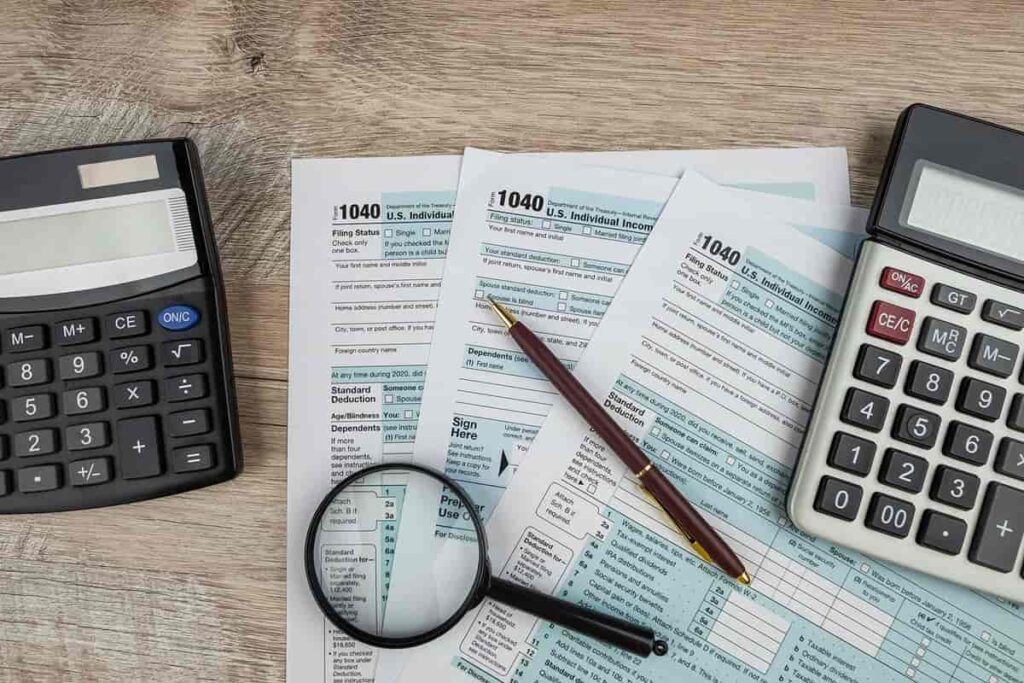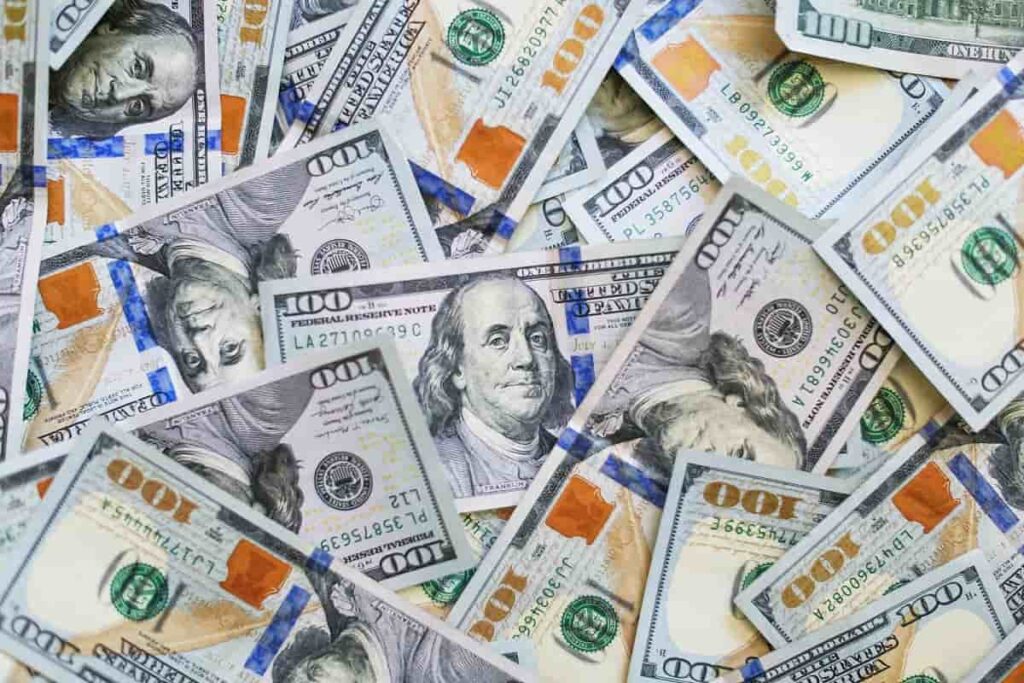Protect Your Portfolio When the U.S. Dollar Collapses
Table of contents

Clickbait titles attract clicks, but rarely does the content engage the reader. Here at Nanalyze, we can do both. When we use clickbait titles, our “time on page” metric ranks among the highest according to the Ministry of Truth, Google. Today’s clickbait title comes directly from one of our paid subscribers who asks the following question:
Do you now or have you any future plans to establish a portfolio of companies that will offset the coming devaluation (or destruction) of the US dollar?
Credit: A Nanalyze Premium subscriber
We need to break this down first. There’s an assumption that the U.S. dollar will be “destroyed,” “devalued,” or in the worst case (shudders) collapse. What do these fear-mongering labels actually mean?
How to Measure U.S. Dollar Strength
First, we need a reliable metric to measure the strength or weakness of the U.S. dollar. You may be tempted to compare the U.S. dollar to a single currency, but that’s a big mistake. Let’s say we’re comparing the U.S. dollar (USD) to the British pound (GBP). If USD declines relative to GBP, is that because GBP grew stronger or is it because USD weakened? What if both currencies weaken together at the same time, or strengthen at the same time? In order to gauge the value of a U.S. dollar abroad, we need to compare it to a basket of currencies. Fortunately, someone’s already been doing that since 1973.
The US Dollar Index – USDX
Built and maintained by Intercontinental Exchange Inc. (ICE), The US Dollar Index values the U.S. dollar relative to a basket of six currencies that represent the U.S.’s most significant trading partners. The currencies are the Euro, Canadian Dollar, Swiss Franc, Japanese Yen, Swedish Krona, and British Pound. It’s not equally weighted, but instead uses the fixed weighting seen below.

It’s an index that we can chart just like any other stock index. Below, you can see how the U.S. dollar has performed over the past 30 years.

In the above chart, the red arrow points to the dot-com era when the U.S. was booming and the blue arrow points to the housing crisis when the U.S. was busting. Pretty predictable stuff, so it’s reasonable to expect that the U.S. dollar will continue to stay within the range seen on the above chart – between 72 and 120. When people talk about the U.S. dollar collapsing, they insinuate that the U.S. dollar will fall dramatically, let’s say to 35 or lower. In doing so, they’re failing to take into account some basic economics.
When The U.S. Dollar Collapses
While an MBA’s job is to pretend to know what they’re talking about, an economist’s job is to actually know what they’re talking about. It’s a common role for economists to try and predict economic cycles like bull and bear markets. Since nobody can do that consistently over time, economists spend their careers being right about half the time, and never end up reaching Maslow’s coveted “self-actualization” tier. Nonetheless, we cannot understand what’s happening without throwing in some simple economics.
Inflation and the U.S. Dollar
Let’s start with a simple example. If you have $100,000 and you lose half of it, you’ve lost half your purchasing power. If you have $100,000 and the price of all goods doubles, you can only buy half as much stuff. Both events have exactly the same outcome. Losing half your purchasing power is like losing half your money. When the price of goods increases over time, that’s called inflation. To protect against inflation we can invest in alternative assets like gold, wine, art, and possibly bitcoin.
Now, let’s consider the U.S. dollar on the global stage. If the dollar strengthens significantly, the Americans can purchase goods from other countries at a cheaper price. If the dollar weakens, then those goods become more expensive, but now more countries are interested in buying American products because they’re cheaper. The USDC chart we saw earlier trades within such a predictable range because of basic economic principles. Aside from some massive black swan event that nobody sees coming, it’s hard to imagine the U.S. dollar suddenly losing half its value on the global stage. But, what if it does?
How to Protect Your Portfolio
While the U.S. dollar could continue strengthening over time, our reader’s question was around the U.S. dollar falling. How can we protect our portfolios from a weakening U.S. dollar, especially given how much USD exposure we have? Telling a broad audience of retail and institutional investors what they ought to do is something an economist would try and pull off. Instead, we’re going to tell you what we plan to do in our own portfolio to hedge our overexposure to the U.S. dollar.
Our reader’s question suggests that one way to protect against a falling U.S. dollar would be to buy foreign stocks (denominated in foreign currencies, of course). Sure, that reduces our exposure to the U.S. dollar, and we’re holding five foreign tech stocks right now. But we’re going to save the “foreign tech stocks” conversation for another article. Right now, we’re going to talk about protecting our pile of U.S. dollars against a decline on the global stage.
We’re currently holding a nearly 25% cash position in our 33 tech stock portfolio. Turns out it’s not all being held in U.S. dollars. Below you can see our currency exposure as of today.
| Currency | Currency Code | Percentage |
| Australian Dollar | AUD | 10.73% |
| Canadian Dollar | CAD | 0.02% |
| Euro | EUR | 0.18% |
| British Pound | GBP | 1.33% |
| Hong Kong Dollar | HKD | 3.32% |
| Swedish Krona | SEK | 4.26% |
| U.S. Dollar | USD | 80.17% |
| 100.00% |
The reason we’re holding foreign currencies is because we’ve been using them to buy foreign stocks. Turns out we’re already holding four of the six currencies from the U.S. Dollar Index basket – GBP, CAD, EUR, and SEK. We’re just missing JPY and CHF.
We no longer need to hold AUD as we’re not presently holding any Australian stocks, nor are we planning to buy any (frankly, we’ve seen a lot of shite on the ASX over the years). We’re also not holding any HKD denominated stocks right now, nor do we plan to buy any Chinese stocks going forward. (Regular readers will know we exited our massive position in BABA at precisely the perfect point in time because our economists are bar none). So, we’ll close our AUD and HKD positions and allocate 10% of our cash into each of the six currencies in the U.S. Dollar Index as seen below:
| Currency | Currency Code | Percentage |
| Swiss Franc | CHF | 10% |
| Canadian Dollar | CAD | 10% |
| Euro | EUR | 10% |
| British Pound | GBP | 10% |
| Japanese Yen | JPY | 10% |
| Swedish Krona | SEK | 10% |
| U.S. Dollar | USD | 40% |
This is not a spur-of-the-moment decision, but rather something we’ve been considering for a while now. As risk-averse investors, we’re always conscious about being overexposed to any particular asset or asset class. We don’t plan on spending our cash anytime soon unless there’s a real buying opportunity (i.e. the market tanks). We’re already overexposed to the U.S. given 27 of the 33 tech stocks we hold are denominated in U.S. dollars, so we’d like to reduce our USD exposure by hedging away some of that risk. This serves to further diversify our portfolio and decreases our overall portfolio risk. But there’s one problem we haven’t considered – negative interest rates.
Negative Interest Rates
We did a double take realizing we’re actually losing money by holding certain currencies because they pay negative interest rates. Holding the Swiss Franc over at Interactive Brokers costs you 78 basis points per year or 3/4 of one percent. (In other words, if you bought $1,000 of Swiss Franc and held it for one year, you’d have $992.2.) Four of the six U.S. Dollar Index currencies have negative interest rates, some far worse than others.
| Currency | Currency Code | Rate |
| U.S. Dollar | USD | 0.09% |
| Canadian Dollar | CAD | 0.24% |
| Swiss Franc | CHF | -0.78% |
| Euro | EUR | -0.56% |
| British Pound | GBP | 0.05% |
| Japanese Yen | JPY | -0.16% |
| Swedish Krona | SEK | -0.16% |
Negative interest rates incent people not to put money in the bank but to spend it instead. An article by The Conversation talks about how this started as a sort of experiment with questionable outcomes. Now we realize how effective this policy is. We don’t like the thought of our cash sweating away its value over time, so what about an ETF that offers the same exposure?
The Invesco DB US Dollar Index Bearish Fund tracks the U.S. Dollar Index and provides exposure to the six currencies we’re looking to hold. Their fee is 0.77%, which means they’re clearly passing on the cost of negative rates. A simple index tracking fund like this should be auto-calculated and have a fee that corresponds with how easily it’s produced.
Even if we incur negative interest rates for four of our currency holdings, we’re still paying less than what Invesco wants to charge us for the same exposure. Hedging our U.S. dollar exposure by purchasing a basket of currencies seems like the optimal solution. It’s also simple enough that even beginner investors can do it.
Conclusion
Today, we’ve been oversimplifying some incredibly complex topics, mainly because we understand so little ourselves. Consequently, we cleaned up a few random forex positions in our portfolio – AUD and HKD – and diversified our stockpile of cash into six currencies that stand to rise if the U.S. dollar falls. We may also use some of our forex holdings to purchase foreign stocks in the future, likely adding to positions we’re already holding. It’s a sensible change to make, and we’ll sleep better tonight knowing we’ve hedged our portfolio against a collapse of the U.S. dollar.
Sign up to our newsletter to get more of our great research delivered straight to your inbox!
Nanalyze Weekly includes useful insights written by our team of underpaid MBAs, research on new disruptive technology stocks flying under the radar, and summaries of our recent research. Always 100% free.















I know forex is a deep subject, but you guys have really engaged my Dunning-Kruger spirit animal. Seriously though, as a beginner, I thank you for a terrific nano-seminar on this topic.
You are quite welcome, and great to hear it’s easily digestible. Forex does start to get pretty complicated which is why we wanted a really simple approach.
Love the term you used, “engaging your Dunning-Kruger spirit animal.” For anyone not in the know, from Wikipedia:
The Dunning–Kruger effect is a hypothetical cognitive bias stating that people with low ability at a task overestimate their own ability, and that people with high ability at a task underestimate their own ability.
It’s that whole “75% of people think they’re better looking than average” concept. That’s a cool topic all by itself.
So, no cryptos or PMs in the hedge against a potential declining dollar equation ?
Hey Mark,
We believe crypto is extremely risky with potentially some large systemic problems being ignored: https://nanalyze.com/2021/12/bitcoin-crash-imminent/
That said, we are holding some bitcoin as part of our overall asset allocation strategy.
What are PMs?
🙂